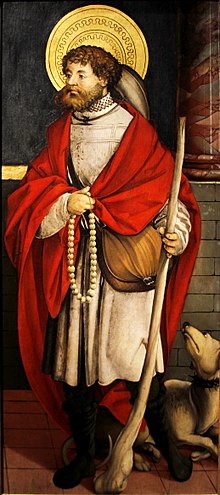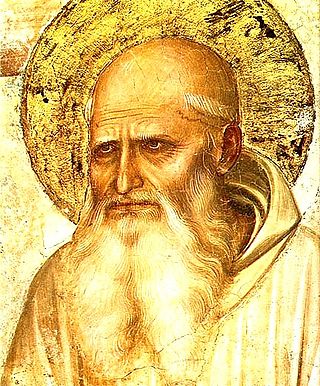
Romuald was the founder of the Camaldolese order and a major figure in the eleventh-century "Renaissance of eremitical asceticism". Romuald spent about 30 years traversing Italy, founding and reforming monasteries and hermitages.
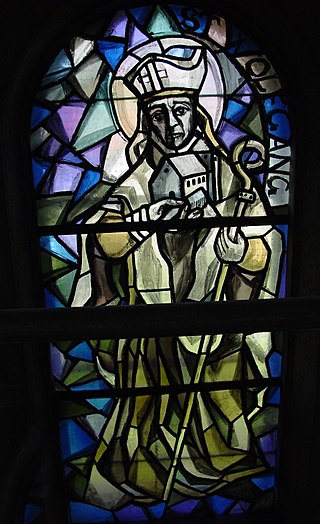
Wolfgang of Regensburg was bishop of Regensburg in Bavaria from Christmas 972 until his death. He is a saint in the Catholic and Eastern Orthodox churches. He is regarded as one of the three great German saints of the 10th century, the other two being Ulrich of Augsburg and Conrad of Constance. Towards the end of his life Wolfgang withdrew as a hermit to a solitary spot, in the Salzkammergut region of Upper Austria. Soon after Wolfgang's death many churches chose him as their patron saint, and various towns were named after him.

Fiacre is the name of three different Irish saints, the most famous of which is Fiacre of Breuil, the priest, abbot, hermit, and gardener of the seventh century who was famous for his sanctity and skill in curing infirmities. He emigrated from his native Ireland to France, where he constructed for himself a hermitage together with a vegetable and herb garden, oratory, and hospice for travellers. He is the patron saint of gardeners.

Sankt Wendel is a town in northeastern Saarland. It is situated on the river Blies 36 km northeast of Saarbrücken, the capital of Saarland, and is named after Saint Wendelin of Trier. According to a survey by the German Association for Housing, Town Planning and Land Use Regulation, St. Wendel is known to be one of the wealthiest regions in Germany, behind Starnberg in Bavaria.

Tholey Abbey in Tholey, in the district of Sankt Wendel in Saarland, is a Benedictine monastery dedicated to Saint Maurice. It is part of the Beuronese Congregation within the Benedictine Confederation.

Auxentius of Bithynia was a hermit born circa AD 400 in Syria, and died February 14, 473, on Mount Scopas.

Meinrad, OSB was a German Benedictine hermit and is revered as a Catholic and Orthodox saint. He is known as the "Martyr of Hospitality". His feast day is 21 January.

The Roman Catholic hermitage of Our Lady of the Enclosed Garden is situated in the former Reformed church of Warfhuizen, a village in the extreme north of the Netherlands. It is the only Dutch hermitage currently inhabited by a hermit. The name draws upon the traditional epithet for the Virgin Mary of hortus conclusus or enclosed garden, a reference to the Song of Songs that indicates the Virgin's "perpetual virginity and at the same time her fruitful maternity".
Gunther was a German (Bavarian) Catholic hermit and diplomat, who had quite important role in early history of Hungary and especially Bohemia, thanks to his good personal relationships with the rulers of those countries. In Czech, German and Hungarian settings is venerated as a saint although he never had been officially canonized.

Saint Erhard of Regensburg was bishop of Regensburg in the 7th century. He is identified with an Abbot Erhard of Ebersheimmunster mentioned in a Merovingian diploma of 684. Ancient documents call him also Erard and Herhard.

Drogo of Sebourg, also known as Druon, Dreux, and Drogon, is a Flemish saint. He was born in Epinoy, County of Artois in the French part of the County of Flanders, and died in Sebourg, France. He is known as the patron saint of shepherds and coffee, and his feast day is on April 16.

Saint Procopius of Sázava was a canon and hermit, canonized as a saint of the Catholic church in 1204.

Gelenberg is an Ortsgemeinde – a municipality belonging to a Verbandsgemeinde, a kind of collective municipality – in the Vulkaneifel district in Rhineland-Palatinate, Germany. It belongs to the Verbandsgemeinde of Kelberg, whose seat is in the like-named municipality.

Anthony the Hermit, also known as Anthony of Lérins, is a Christian who is venerated as a saint. He was born in the ancient Roman province of Pannonia Valeria, then part of the Hunnic Empire. When he was eight years old, his father died and he was entrusted to the care of the abbot Severinus of Noricum, in modern-day Austria. Upon the death of Severinus in 482, Anthony was sent to Germany and put in the care of his uncle, Constantius, an early Bishop of Lorsch. While there, Anthony is thought to have become a monk at the age of twenty.

St. Matthias' Abbey is a Benedictine monastery in Trier, Rhineland-Palatinate, Germany.
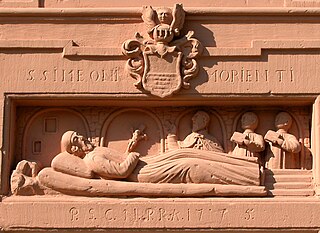
Saint Simeon of Trier, also Symeon, was a monk and recluse who died in Germany in 1035. He is venerated as a saint in the Eastern Orthodox Church with his feast day on May 1, and in the Catholic Church in Germany.

October 20 - Eastern Orthodox liturgical calendar - October 22
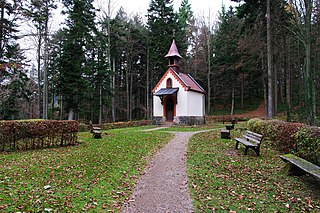
The small St. Wendelin's Chapel is located about 750 metres east of St. Odile above the Musbach valley, Germany, on the Small Roßkopf, a spur of the Roßkopf, at a height of 540 m. It belongs to the parish of St. Hilarius in Freiburg's suburb Ebnet. It is named after Saint Wendelin, a king's son who lived as a shepherd and hermit. Wendelin is the patron saint of shepherds and flocks. According to the documents of the Capuchins the first chapel was built of wood in 1723 and served the herdsmen from Ebnet also as a protection against storms. Pilgrims who went from Freiburg over the Roßkopf to St. Peter used this chapel as a shelter and for devotion. The present stone chapel was funded and built by the citizens of Ebnet in 1895. Even today it is maintained from Ebnet.

Paulus of Verdun (576-648) was a bishop of Verdun in the Lorraine region of France from 630 until his death in 647 or 648.

Saint Rodingus was an Irish monk and abbot in Beaulieu-en-Argonne, France. His feast day is 17 September.
